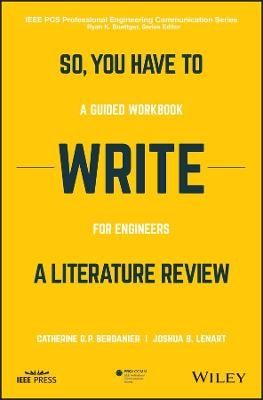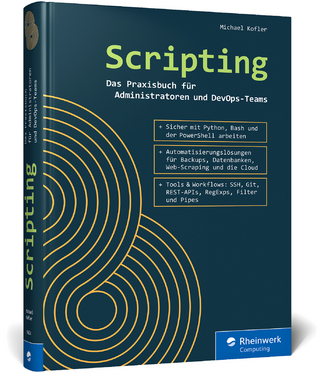
So, You Have to Write a Literature Review
Wiley-IEEE Press (Verlag)
978-1-119-55502-5 (ISBN)
So, You Have to Write a Literature Review presents a dynamic and practical method in which engineering students—typically late-career undergraduates or graduate students—can learn to write literature reviews, and translate genre-based writing instruction into easy-to-follow, bite-sized activities and content. Written in a refreshingly conversational style while acknowledging that writing is quite difficult, Catherine Berdanier and Joshua Lenart leverage their unique disciplinary backgrounds with decades of experience teaching academic engineering writing in this user-friendly workbook.
DR. CATHERINE BERDANIER is an Assistant Professor of Mechanical Engineering in the Department of Mechanical Engineering at Pennsylvania State University at University Park. She holds an M.S. in Aeronautical Engineering and a Ph.D. in Engineering Education from Purdue University. Her research focuses mainly on graduate-level engineering education with emphasis on engineering writing and communication, attrition, and persistence. Her research has been funded through multiple NSF awards. She is the Director of the Engineering Cognitive Research Laboratory (E-CRL), where she and her graduate students investigate questions concerning the human side of engineering through a variety of quantitative, qualitative, experimental, and analytical methods. DR. JOSHUA LENART is an Associate Instructor with the Communication, Leadership, Ethics, and Research (CLEAR) Program at the University of Utah where he also received his Ph.D. in Writing and Rhetoric Studies and now teaches technical communication for the College of Engineering. His teaching expertise includes administrative and organizational writing, grant writing, teambuilding, and strategic communications. His research expertise focuses on natural resource management policy as it relates to landscape-scale impacts on wildlife habitat, hydrologic systems, community resilience, adaptation planning, and long-term land use conservation. For the past five years, he has led various transdisciplinary research projects examining land, water, and wildlife resource management conflicts vis-à-vis policy, stakeholder input, feasibility and environmental impact assessment, and collective impact engagement.
A Note from the Series Editor ix
About the Authors xiii
Acknowledgments xv
About the Book xvii
How to Use This Book xix
1 Why Is Writing So Hard? 1
Overcoming Barriers to Writing and Making Time to Write 1
1.1 Writing as a Cognitive, Social, and Affective Activity 2
1.2 Time Management, Self-Discipline, and the Writing/Research Timeline 4
1.3 Accountability Is an Essential Part of Writing 5
1.3.1 Shut Up & Write Groups 5
1.3.2 Accountability Partners 6
1.3.3 Schedule Your Writing in a Scientific Way 7
1.3.4 Deliberate and Distributed Practice 7
1.3.5 Bribery 8
References 9
2 What Is the Point of a Literature Review, Anyway?! 11
2.1 The Literature Review Serves as an Argument to Establish a Gap in Prior Research 12
2.2 The Literature Review Establishes the Author’s Credibility 13
2.3 The Literature Review Prepares Readers to Interpret and Appreciate Your Findings 15
2.4 Envisioning Your Audience 15
2.5 Deliberate Language Choices Support the Functions of the Literature Review 16
Reference 17
3 Gathering and Storing Literature 19
3.1 What to Cite? The Difference Between Types of Academic Publications 19
3.2 What NOT to Cite: Types of Documents to Avoid Citing 21
3.3 Searching for Literature 23
3.4 Saving and Storing Your Literature 23
3.5 Reference Managers 27
3.6 Your Turn: Collecting Literature 27
3.7 But How Many References Do I Need in My Literature Review?! 30
4 Reading Strategies and Remembering What You Read 33
4.1 Deciding Whether to Skim or Read 33
4.2 What Are You Focusing On? 34
4.3 Effective Methods for Skimming Literature 36
4.4 Reading Scholarly Literature 38
4.5 Taking Notes and Starting an Annotated Bibliography (or: Helping Your “Future Self”) 39
References 42
5 Finding Connections Between Literature 43
5.1 Identifying Overarching Themes and Topics in Literature 44
5.2 Identifying “Synthesis” of Literature in Action 46
5.3 Drawing Connections Between Literature 48
5.4 Justifying “Gaps in the Literature” 49
6 Organizing Your Literature Review 53
6.1 Envisioning the Macrostructure of Your Literature Review 54
6.2 A Discussion on Topic Sentences: The First Sentence of the Paragraph 61
6.3 Creating a Macrostructure for Your Own Literature Review 61
7 Writing the “Ugly Draft” 65
7.1 Twelve Steps to Building Your Literature Review 65
7.2 Strategies to Help You Build and Sculpt Paragraphs: Introducing Rhetorical Moves and Steps in Genre Maps 69
7.3 If You Are Not into Outlines … Leverage Who You Are as a Writer to Get that Ugly Draft on Paper! 73
References 73
8 Using Citations to Connect Ideas 75
8.1 The Proximity of the Citation to the Reference Carries Meaning 75
8.1.1 String Citations 76
8.1.2 Topic Citations 77
8.1.3 End-of-Sentence Citations 78
8.1.4 Direct Citation 79
8.2 Literature Occurs in the Past, but a Literature Synthesis Points to YOUR Future 81
8.3 The “Accordion Stage” of Writing a Literature Review Will Hone the Density of Citations and Conciseness 83
8.4 The Literature Review Is a Political Document 84
9 Revising the “BIG Four” Literature Review Faux Pas 87
9.1 Ineffective or Missing Topic Sentences 87
9.1.1 All Sentences That Follow the Topic or Umbrella Sentence Should Directly Support That First Sentence 88
9.1.2 There Is Rarely a Need to Directly Cite One Article or Author in the Topic Sentence 89
9.2 Fluffy Writing 91
9.3 Globalisms 91
9.4 Lack of Connection or Synthesis Between Topics or Articles 93
Reference 96
10 Am I Done Yet? 97
10.1 Self-Check Yourself Before You Wreck Yourself 97
11 Interpreting Advisor Feedback 101
11.1 Conclusion: Our Wishes for You 103
12 Theory Behind the Practice 105
For Instructors and Advisors 105
12.1 On Genre Studies and Moves-Steps Analysis 106
12.2 On Technical Writing for Engineers 109
12.3 On Writing Literature Reviews 111
12.4 On Grammar Editing and Revision Strategies 113
12.5 Last Thoughts 116
References 116
Index 119
| Erscheinungsdatum | 20.10.2020 |
|---|---|
| Reihe/Serie | IEEE PCS Professional Engineering Communication Series |
| Mitarbeit |
Herausgeber (Serie): Ryan K. Boettger |
| Sprache | englisch |
| Maße | 10 x 10 mm |
| Gewicht | 454 g |
| Themenwelt | Mathematik / Informatik ► Informatik ► Netzwerke |
| Technik ► Elektrotechnik / Energietechnik | |
| ISBN-10 | 1-119-55502-7 / 1119555027 |
| ISBN-13 | 978-1-119-55502-5 / 9781119555025 |
| Zustand | Neuware |
| Haben Sie eine Frage zum Produkt? |
aus dem Bereich


